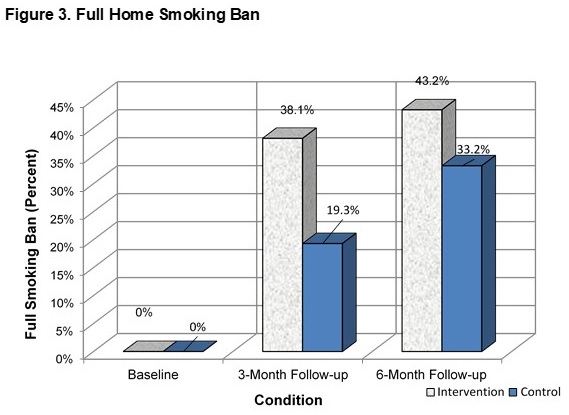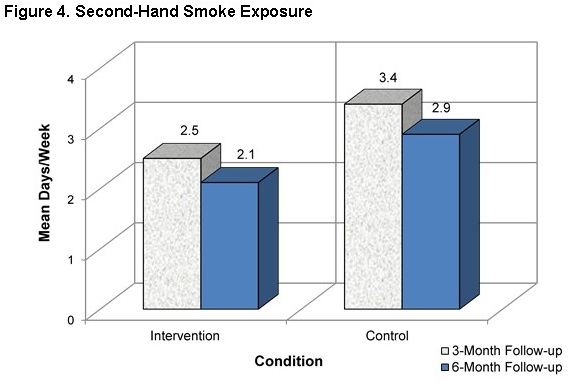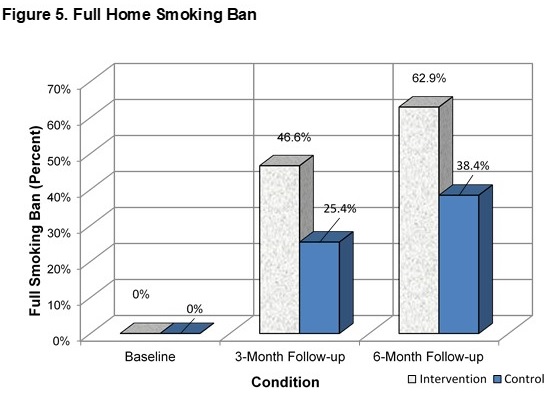Program Synopsis
Designed to promote home smoking bans to reduce second-hand smoke exposure in the home, this intervention consists of various mailed materials (including a guide describing the steps to establishing a smoke-free home) and one coaching call that together apply strategies of persuasion, role modeling, goal setting, environmental cues, and written and verbal reinforcement of actions taken to create smoke-free homes. The studies showed higher implementation of a full home smoking ban and decreased exposure to second-hand smoke.
Program Highlights
Program Materials
Preview and order the materials from the developer
Featured Profile
Learn more about this program and the developer who created it
Insights from the Cancer Control Field
See how implementers have used this program in the field
Program Scores
The Need
Each year in the United States, 58 million non-smokers are exposed to second-hand smoke, which can be harmful even when exposure is brief. Since 1964, approximately 2.5 million non-smokers have died due to exposure to second-hand smoke. Among adults, who are most commonly exposed at home or at work, second-hand smoke causes heart disease, stroke, and lung cancer. From 2005 to 2009, for example, second-hand smoke caused nearly 34,000 heart disease deaths and more than 7,300 lung cancer deaths. Children, who are most often exposed to second-hand smoke in the home, are placed at greater risk of ear infections, more frequent and severe asthma attacks, respiratory symptoms and infections, and sudden infant death syndrome (SIDS). An estimated two out of every five children aged 3-11 in the United States are exposed to second-hand smoke regularly. The U.S. Surgeon General recommends that adults maintain smoke-free homes to protect the health of their loved ones. Communities can encourage adults to implement smoking bans in their homes to reduce second-hand smoke exposure.
The Program
Smoke-Free Homes: Some Things Are Better Outside is a home-based intervention that promotes home smoking bans and the reduction of second-hand smoke exposure. It is designed for adults who live in a home in which at least one smoker and at least one non-smoker reside and who allow smoking inside their homes. The program was originally implemented in partnership with local 2-1-1 call centers. 2-1-1 is a national information and social services referral system that receives 15 million calls per year. (Compared with the general population, 2-1-1 callers are disproportionately low income, unemployed, and uninsured, and they have fewer years of education and higher smoking rates.) Based on the social cognitive theory and the transtheoretical model’s stages of change, Smoke-Free Homes includes strategies of persuasion, role modeling, goal setting, environmental cues, and written and verbal reinforcement of actions taken to create smoke-free homes. The goal of the program is to help households reduce second-hand smoke exposure by establishing a smoke-free home, one that does not allow smoking in any room at any time.
The four parts of the intervention—three mailings and one coaching call—are conducted in 2-week intervals over a 6-week period:
-- Mailing 1. Participants receive the Smoke-Free Homes Kit, which includes various interactive components (i.e., guide, worksheet, factsheet, pledge card, signs, stickers, window cling, reference information) designed to guide them and their household members in establishing a home smoking ban. The 5-Step Guide teaches participants the five steps for making their homes smoke free: decide to make the home smoke free, talk to people who reside in the home about making the home smoke free, set a date to implement the change, make the home smoke free, and keep the home smoke free.
-- 10- to 20-minute coaching call from a program specialist. The call supplements the materials participants receive in the kit. After discussing the importance of creating a smoke-free home, the program specialist assesses the participant’s confidence in making this change and then leads the participant through relevant steps in the 5-Step Guide.
-- Mailing 2. The second mailing includes a booklet describing common challenges and solutions associated with making a smoke-free home, a photo story illustrating aspects of creating a smoke-free home (e.g., having a conversation with the smoker in the home, finding ways to make smoking outside easier, celebrating being smoke free), and an e-cigarette information sheet that explains the potential harms of second-hand smoke exposure from e-cigarettes and similar electronic smoking devices.
-- Mailing 3. This mailing consists of a newsletter (which includes testimonials and success stories from families who have successfully created a smoke-free home), a factsheet on third-hand smoke, stickers, and a window cling.
Time Required
-- 6 hours for optional program specialist training offered in-person by the program development team
-- 5 minutes to prepare mailings for each participant
-- 10 to 20 minutes for each coaching call
Intended Audience
The intervention is intended for adults living in a home in which at least one smoker and at least one non-smoker reside and who allow smoking inside their homes.
Suitable Settings
This intervention is intended to be implemented in home settings but can be delivered in a range of settings.
Required Resources
Required resources to implement the program include the following:
-- Smoke-Free Homes: Some Things Are Better Outside website
For costs associated with this program, please contact the developer, Michelle Kegler. (See products page on the EBCCP website for developer contact information.)
About the Study
Three studies were reviewed for this summary. In all three studies—which were conducted in Atlanta, Georgia, 63 North Carolina counties, and Houston, Texas—the intervention and methodology were the same. Inclusion criteria were being older than 18 years of age, having the ability to speak and understand English, being a smoker living with at least one non-smoker (including children) or a non-smoker living with at least one smoker, and living in a home that did not have a full smoking ban. Participants in the control condition did not receive any intervention.
Study 1
In Georgia, 498 callers were randomized in the study: 246 to the intervention group and 252 to the control group. The average age was 40.2 years; 82.7% were female, 83.3% were African American, 11.5% were White, and 5.0% were “other.” The majority (79.7%) of participants were smokers, and 65.3% lived in a home in which at least one non-smoking adult resided. Further, 75.1% had at least a high school education, and most (78.9%) lived with at least one child who was under the age of 18. The intervention and control groups did not differ significantly on any baseline variables.
Study 2
In North Carolina, 500 callers were randomized in the study: 260 to the intervention group and 240 to the control group. The average age was 39.7 years; 87.2% were female, 61.4% were African American, 30.8% were White, and 7.8% were “other.” The majority (76.6%) of participants were smokers, and 59.0% lived in a home in which at least one non-smoking adult resided. Further, 79.2% had at least a high school education, and most (79.8%) lived with at least one child who was under the age of 18. Groups were equivalent at baseline on all variables, except the intervention group—compared with the control group—had a greater proportion of households in which all adults were smokers (45.8% vs. 35.8%).
Study 3
In Texas, 508 callers were randomized in the study: 258 to the intervention group and 250 to the control group. The average age was 41.1 years; 82.9% were female, 65.2% were African American, 18.9% were White, 12.0% were Latino, and 3.9% were “other.” The majority (71.3%) of participants were smokers, and 74.6% lived in a home in which at least one non-smoking adult resided. Further, 78.5% had at least a high school education, and most (68.3%) lived with at least one child who was under the age of 18. At baseline, groups significantly differed on gender and race/ethnicity variables, with the intervention group having a greater proportion of women and African Americans compared with the control group.
Outcomes
The main outcome measures were full home smoking ban and second-hand smoke exposure. To assess the presence of a smoking ban at baseline and 3- and 6-month follow-up, participants in all three studies were asked over the phone, “Which statement best describes the rules about smoking inside your home?” The response options were “smoking is not allowed anywhere inside your home” (full ban), “smoking is allowed in some places or at some times” (partial ban), “smoking is allowed anywhere inside your home” (no ban), and “there are no rules about smoking inside your home” (no ban). Based on the inclusion criteria, none of the participants had a full smoking ban in their homes at baseline.
Second-hand smoke exposure was also assessed in the Atlanta and North Carolina studies. At 3- and 6-month follow-up, participants were asked over the phone, “During the past 7 days, how many days have people smoked in your home in your presence?”
In the assessment of secondary outcomes, smokers were asked at baseline, 3-month follow-up, and 6-month follow-up about the number of cigarettes they smoked per day, their number of quit attempts in the past 3 months (daily smokers only), and their confidence in quitting.
Key Findings
Study 1

- A greater proportion of participants in the intervention group than in the control group implemented a full home smoking ban at 3-month follow-up (p<.001) and 6-month follow-up (p=.002).

- Over time, participants in the intervention group were exposed to second-hand smoke on fewer days compared with participants in the control group (p<.001).
Study 2

- A greater proportion of participants in the intervention group than in the control group implemented a full home smoking ban at 3-month follow-up (p<.001) and 6-month follow-up (p=.02).

- Over time, participants in the intervention group were exposed to second-hand smoke on fewer days compared with participants in the control group (p=.0004).
Study 3

- A greater proportion of participants in the intervention group than in the control group implemented a full home smoking ban at 3-month follow-up (p<.0001) and 6-month follow-up (p<.0001).
Additional Findings
Study 1
- Among smokers, the mean number of cigarettes smoked per pay was lower in the intervention group than in the control group at 3-month follow-up (p<.001) and 6-month follow-up (p=.02).
- At 3-month follow-up, smokers in the intervention group had a higher number of quit attempts (p=.003) and higher confidence in being able to quit (p<.001) compared with smokers in the control group; these group differences were no longer significant at 6-month follow-up.
Study 2
- At 3-month follow-up, smokers in the intervention group had higher confidence in being able to quit compared with smokers in the control group (p=.03); this group difference was no longer significant at 6-month follow-up, although it was significant in longitudinal intent-to-treat analyses.
Study 3
- Among smokers, the mean number of cigarettes smoked per day was lower in the intervention group than in the control group at 3-month follow-up (p=.03); this group difference was no longer significant at 6-month follow-up, although it was significant in longitudinal intent-to-treat analyses.


